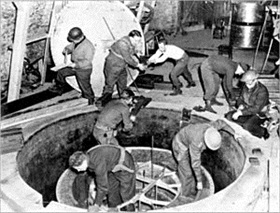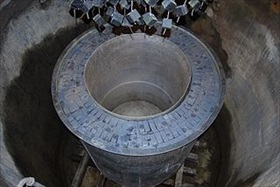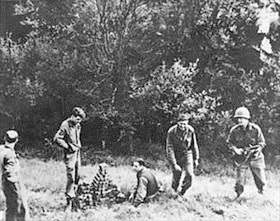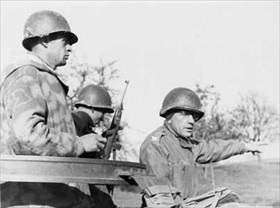GERMAN NUCLEAR PHYSICS INSTITUTE FALLS TO SOVIETS
Berlin, Germany • April 25, 1945
In the same month World War II began in Europe, September 1939, the German Army Weapons Agency (Heereswaffenamt, or HWA) placed all programs associated with the nation’s nascent nuclear energy project under its authority. The weapons program eventually expanded into three main efforts: setting up a nuclear reactor (which the Germans called a Uranium Machine), producing uranium and heavy water (deuterium oxide) (the Allies mounted a bombing and sabotage campaign against the Norsk Hydro heavy water plant in German-occupied Norway), and separating uranium isotopes, a process required to prepare enriched uranium for use in nuclear weapons. Likewise, the prestigious and independent Kaiser Wilhelm Institute for Physics (KWIP) in the Berlin suburb of Dahlem was placed under HWA authority. (German-born theoretical physicist Albert Einstein served as KWIP’s head from 1914 to 1932.) In June 1942 the program, along with its seventy scientists, was handed off to the Reich Ministry for Armament and Ammunition under Albert Speer.
Toward the end of the war, the Allied powers competed to obtain surviving components of the Nazis’ nuclear weapons program, just as they famously did with the V‑2 ballistic rocket program. The Soviets used special search teams in conquered territories to identify and “requisition” equipment, materiel, intellectual property, and particularly scientists, physicists, mathematicians, and engineers who could be useful in invigorating their own atomic research program in a supersecret institute simply called Laboratory Number 2 outside Moscow.
On this date, April 25, 1945, the Soviets captured Berlin’s Dahlem suburb and with it the Kaiser Wilhelm Institute for Physics. Capturing the Kaiser Wilhelm Institute intact was enormously important to the Soviets, who knew of the institute’s reputation and that it would soon be relocated in the French-designated occupation zone. As luck would have it, the Nazis had dispersed much of the institute’s equipment and personnel to the edge of the Black Forest in Southwestern Germany, which lay astride the Western Front. This move allowed Allied military officers, intelligence personnel, and scientific and technical specialists in the secret Alsos Mission (Operation Alsos), part of the U.S. Manhattan Project to build the world’s first nuclear bomb, to follow close behind front lines, and occasionally behind enemy lines and to take into custody most of Germany’s senior nuclear research personnel and technicians. These scientific commandos, who referred to themselves as the “bastard brigade” because they worked independently, unattached to any larger military group, sent dismantled equipment and reams of documents back to the U.S. for evaluation and prevented high-value scientific assets from falling into Soviet (or French) hands. With a nuclear research program glass half-empty, as it were, the Soviets managed to evacuate a large number of KWIP scientists from Berlin, along with 250 kilograms of metallic uranium, three tons of uranium oxide, and 20 liters of heavy water, to the Soviet Union, giving their nuclear program an important boost.
Alsos Mission: U.S. and British Intelligence-Gathering Operation, Late 1943 to October 1945
 |  |
Left: The objective of the Alsos Mission was to secure atomic material and capture the scientists working on the Nazi atomic weapons project. As part of Operation Big Bang, British and American members of the mission are pictured here dismantling the experimental nuclear reactor that German scientists and technicians had built as part of their country’s nuclear weapons project in Haigerloch, a rustic village about 35 miles/56 km southwest of Stuttgart in the southwestern state of Baden-Wuerttemberg. The reactor was nestled in a natural cave 25 yards/23 meter deep at the base of an 80‑ft/24‑m-tall limestone cliff. Dubbed the “atom cellar” by Alsos team members, it contained the precious German Uranium Machine in the shape of a cylinder bored into the limestone floor and lined with graphite blocks enclosing a central aluminum vat that would have been filled with heavy water; the reactor was missing both uranium and heavy water at the time of its discovery. The Germans had evacuated and dismantled their nuclear reactor before Alsos’s arrival.
![]()
Right: Replica of the German experimental nuclear reactor at Haigerloch Museum. Hanging above the reactor’s aluminum vat are strings of fake uranium cubes. In late March 1945 German scientists came close to creating a working nuclear reactor when they lowered hundreds of uranium cubes into Haigerloch’s aluminum vat filled with heavy water—this 28 months after Enrico Fermi and his team of American scientists had demonstrated the first sustaining nuclear reactor at the University of Chicago on December 2, 1942. Alsos dealt the Nazi atomic bomb project a mortal blow by setting a charge of dynamite that collapsed the roof of the atom cellar, literally bringing the curtain down on the last lingering remnants of the German “Manhattan Project.”
 |  |
Left: Once the atom cellar was buried under tons of limestone rock, members of the Alsos Mission set out lickety-split to capture the brains behind the Haigerloch reactor, any associated technical documentation, and the missing uranium and heavy water. Quickly, 3,000 lb/1.36 metric tons of heavy water were recovered in oil drums hidden in a grist mill 3 miles/4.82 km distant; the technical documentation—indeed, practically the whole archive of the Nazi atomic bomb project—was flushed out of a cesspool. Similarly, two tons of uranium in the form of hundreds of 2-inch/5-cm cubes—the vast majority of the Nazis’ uranium horde—were recovered in a field atop a nearby hill, as seen in this photo. Fearing booby traps, Alsos forced German POWs to dig up the cubes, some of which were kept as souvenirs by the Alsos scientists.
![]()
Right: The American sweep of Southwestern Germany—an area that was scheduled to be occupied by the French—was led by the hard-charging World War I veteran Col. Boris Pash (right in photo). The sweep denied the French the immediate postwar advantage that accrued to the U.S. and British nuclear weapons programs.
The Alsos Mission: Discovering the Extent of Germany’s Nuclear Weapons Program
![]()

 History buffs, there is good news! The Daily Chronicles of World War II is now available as an ebook for $4.99 on Amazon.com. Containing a year’s worth of dated entries from this website, the ebook brings the story of this tumultuous era to life in a compelling, authoritative, and succinct manner. Featuring inventive navigation aids, the ebook enables readers to instantly move forward or backward by month and date to different dated entries. Simple and elegant! Click
History buffs, there is good news! The Daily Chronicles of World War II is now available as an ebook for $4.99 on Amazon.com. Containing a year’s worth of dated entries from this website, the ebook brings the story of this tumultuous era to life in a compelling, authoritative, and succinct manner. Featuring inventive navigation aids, the ebook enables readers to instantly move forward or backward by month and date to different dated entries. Simple and elegant! Click 











